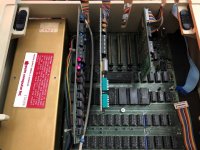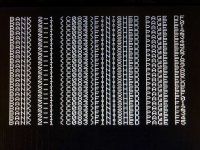Witchy
Experienced Member
Hi folks,
I've been running up and testing my oldest Apple ][+ to resurrect the first program I ever wrote in Apple Structured BASIC and getting ADTPro 2.10 going on it. Today I powered up and the display was rolling so I tweaked the horizontal hold on the monitor which fixed it for a bit then it went again. Thinking it was the screen I tried an LCD TV with composite input, same problem, then my trusty Sony PVM which also had the same problem.
So it's the video output on the ][+ at fault. Looking at Mike Willegal's link to the Apple][ Service Notes it says 'rolling video B14 74LS32/C11 74LS04. Trouble is my board doesn't have a 74LS32 at B14, both B13 and 14 are 74LS02s. There IS an LS32 at C14 but that tests OK, as does the LS04 at C11. Looking at Mike's reproduction board it doesn't have B14 either.
I'm surprised this doesn't seem to me a more searchable problem. Anyone else seen it?
Cheers!
I've been running up and testing my oldest Apple ][+ to resurrect the first program I ever wrote in Apple Structured BASIC and getting ADTPro 2.10 going on it. Today I powered up and the display was rolling so I tweaked the horizontal hold on the monitor which fixed it for a bit then it went again. Thinking it was the screen I tried an LCD TV with composite input, same problem, then my trusty Sony PVM which also had the same problem.
So it's the video output on the ][+ at fault. Looking at Mike Willegal's link to the Apple][ Service Notes it says 'rolling video B14 74LS32/C11 74LS04. Trouble is my board doesn't have a 74LS32 at B14, both B13 and 14 are 74LS02s. There IS an LS32 at C14 but that tests OK, as does the LS04 at C11. Looking at Mike's reproduction board it doesn't have B14 either.
I'm surprised this doesn't seem to me a more searchable problem. Anyone else seen it?
Cheers!


